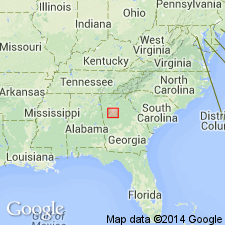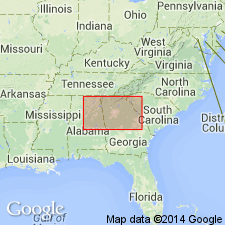
- Usage in publication:
-
- Inman Yard Formation*
- Modifications:
-
- Named
- Dominant lithology:
-
- Gneiss
- Schist
- AAPG geologic province:
-
- Piedmont-Blue Ridge province
Summary:
The Inman Yard Formation, here named, consists of interlayered gneiss, schist, and granite gneiss. As the apparently oldest unit in the Atlanta Group in the Newnan-Tucker synform, the base is not exposed. Underlies the Norcross Gneiss with sharp and apparently conformable contact. Thickness is 700 m. Age is Late Proterozoic and (or) early Paleozoic.
Source: GNU records (USGS DDS-6; Reston GNULEX).

- Usage in publication:
-
- Inman Yard†
- Modifications:
-
- Abandoned
- AAPG geologic province:
-
- Piedmont-Blue Ridge province
Summary:
The Inman Yard Formation is abandoned because it is now known to be Clairmont melange and is part of the Clairmont Formation [now Clairmont Member of Stonewall Gneiss] in the Clairmont thrust sheet.
Source: GNU records (USGS DDS-6; Reston GNULEX).
For more information, please contact Nancy Stamm, Geologic Names Committee Secretary.
Asterisk (*) indicates published by U.S. Geological Survey authors.
"No current usage" (†) implies that a name has been abandoned or has fallen into disuse. Former usage and, if known, replacement name given in parentheses ( ).
Slash (/) indicates name conflicts with nomenclatural guidelines (CSN, 1933; ACSN, 1961, 1970; NACSN, 1983, 2005, 2021). May be explained within brackets ([ ]).

